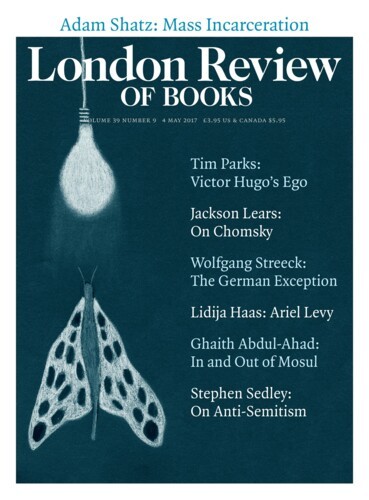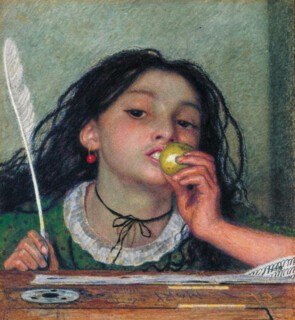Roger Fry , when comparing the Pre-Raphaelites with the Impressionists, described the artistic innovations of the former as an insurrection in a convent, whereas the latter were real revolutionaries. The simile may have been unconsciously prompted by an elaborate and highly finished drawing of hysterical nuns entangled with fanatical Huguenots who are disentombing the body of Queen Matilda. This drawing by the young Millais is currently on display in an exhibition at Tate Britain of Pre-Raphaelite works on paper (until 7 May). The calculated confusion of rigid and angular figures, although it owes something to the medieval art cherished by the nuns (some examples of which feature in the background), can’t simply be dismissed as revivalism. Such a thorough determination to avoid being in any way easy on the eye or the mind may once have seemed a peculiar by-product of the reactionary antiquarian ecclesiology of the late 1840s but it now seems to anticipate (although it clearly didn’t influence) the daring aesthetic discomforts devised by ‘Modern British’ artists, even the wiry, tortured sculptures of a hundred years later by Lynn Chadwick or Reg Butler.
This drawing, and the finished study by Millais for Christ in the House of His Parents (also of 1849) which hangs beside it, are familiar enough to students of British art, but the exhibition, which has been very little publicised and is rather hidden away at the east end of the Clore Galleries, includes several little-known masterpieces. The most startling of these is Ford Madox Brown’s watercolour of 1863, entitled Mauvais Sujet, of a young teenage girl who is not so much engagingly naughty as alarmingly bad. The tight format derives from Rossetti’s early oil paintings of female heads and shoulders, such as Bocca Baciata of 1859, paintings of a frank sensuality free of the narcotic eroticism and religiosity that make so much of his later painting seem repellent. But Brown’s schoolgirl subject hasn’t yet led any artist into temptation. She is seated at a high desk with names and doodles scratched on its hinged top. We see the lines she has been made to copy with her quill, black lines which rhyme with the disorder of her hair. Her teeth – brighter than the white of her collar, the plume, the paper or the enamel inkwell – are biting into a brilliantly green apple. Fruit would certainly not have been allowed in the classroom and this young Eve, whose dress is also green, eats it with resentful defiance. The picture has the compositional ingenuity and thrilling compression of Brown’s great circular painting The Last of England – a compression, here greatly enhanced by the original double frame, that we miss in his later work, although he was always attracted both by defiance and by teeth.
In a glass case nearby, there are drawings by the young Burne-Jones, including one on vellum for Ezekiel and the Boiling Pot of about 1860. The densely textured pen work, the tilted perspective, the way the distant deathbed scene is aligned with the head of the foreground figure, all derive from Rossetti, but the dark setting, which means that Ezekiel is almost a silhouette, and the unorthodox handling – flames and smoke from the fire and steam from the pot are rendered by violent rubbing and scratching – may have been suggested by Millais’s Autumn Leaves, where strands of hair are incised against the evening sky and the smoke of the bonfire is smudged with a rag.
It was in 1860 that the National Gallery acquired its first painting in the style of Mantegna – the small Noli Me Tangere (not now displayed on the main floor). It seems to have combined with the increasing availability of exquisite 15th-century metal point drawings, both in London collections and in photographic reproduction, and a gradual awareness of the art of Botticelli, to help Burne-Jones to devise a style, and create a ‘world’ of intricately swaddled, somnambulistic figures, yearning anorexics, attenuated trees and sinuous streams with minutely pebbled borders. He was far more successful making drawings on a small scale, on paper or vellum, than when painting on canvas, and yet his work derives much of its strength from monumental aspirations. The present exhibition includes the preparatory study in ‘gouache, gold paint and ink on paper’ for murals showing the story of Perseus, intended for the home of the young Arthur Balfour. Here we also see how the reluctant action of his figures can be accompanied by dynamic and even violent patterns in the borders and backgrounds.
It dates from about 1875, a couple of years after Mantegna’s Triumph of Scipio, one section of a fictive sculptural frieze, had been acquired by the National Gallery. Burne-Jones may have taken from Mantegna not only the reduced palette but the idea of having some parts of his narrative imitate cut-out low relief – in this case of silver (or the new metal, aluminium) set, not against figured marble, as in Mantegna, but against wood grain, matching the frame of the doorway below. The wood grain is rendered by sweeping the wet paint up and down with rag. Such a connection would have been easier to detect in 1919 when it was presented to the ‘National Gallery Millbank’, not only because the two galleries had not yet been formally separated, but because the dogmas of modernism had only just begun to gather strength. When, decades later, a new interest in Victorian art developed, first among collectors and then among academics, few of the enthusiasts for Millais or Burne-Jones were much interested in the Quattrocento.
Send Letters To:
The Editor
London Review of Books,
28 Little Russell Street
London, WC1A 2HN
letters@lrb.co.uk
Please include name, address, and a telephone number.


